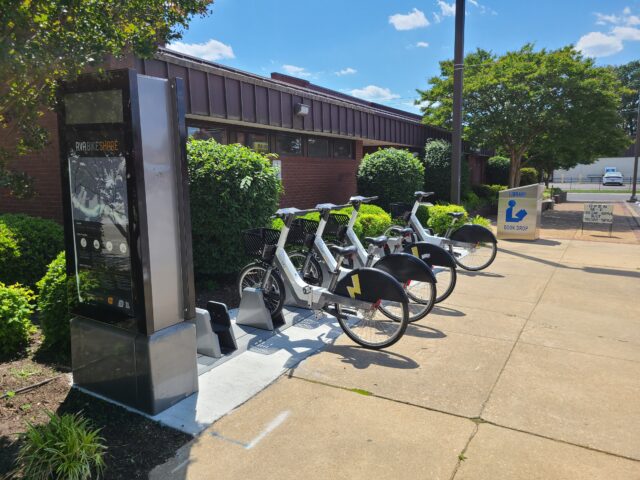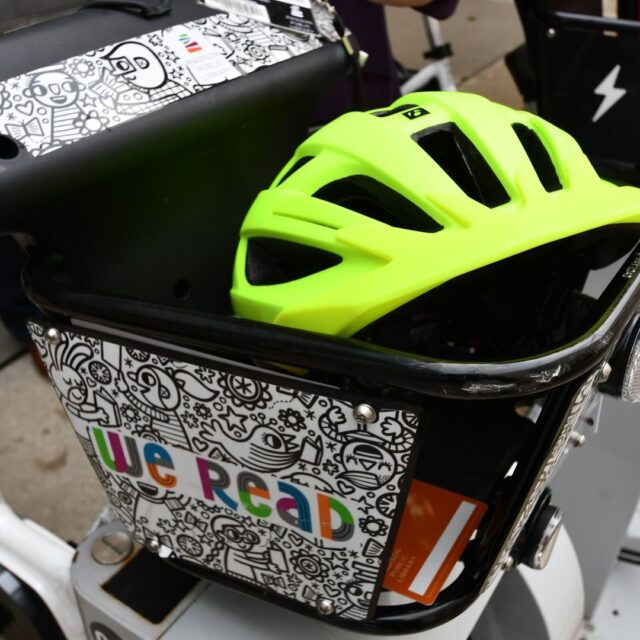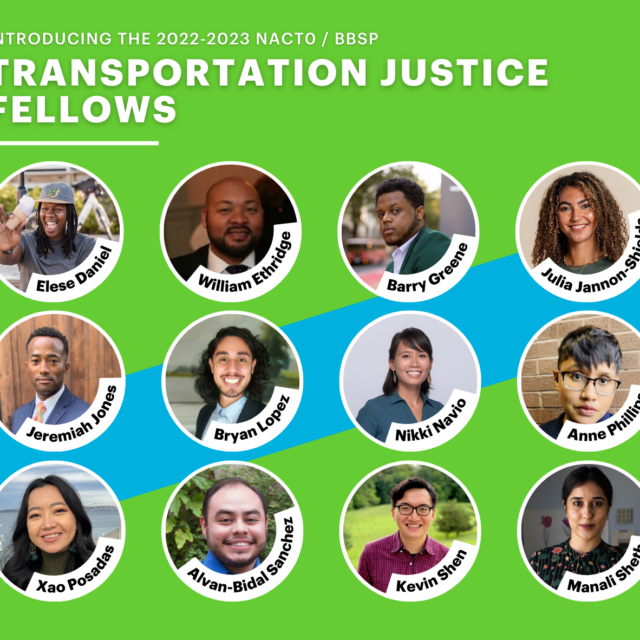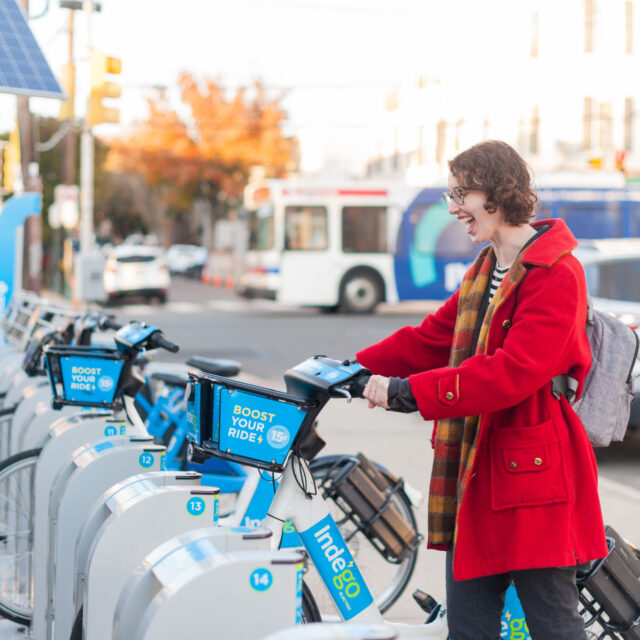Three Ways to Help Close the Bike Share Equity Gap
by Barry Greene Jr., 2023 Transportation Justice Fellow
March 8, 2023
In Richmond, Virginia, intentional efforts have added up to make shared micromobility in the city more accessible.

The RVA Bike Share station at the North Avenue Branch Library in Richmond, Virginia.
When I made the choice to return home to Richmond, Virginia, a deciding factor was the bike culture. There are several different bike communities in the 226,000-person capital city, from recreational bicyclists to urban commuters, cyclocross lovers to avid mountain bikers, almost all of whom enjoy riding the trails along the James River, the city’s skyline as their backdrop. Richmonders take their cycling seriously and with the introduction of micromobility and bike share to the city, I knew I’d be able to adopt a car-free lifestyle.
Despite Richmond’s hilly terrain, its relative density allows for navigating the city by bike in a reasonable and timely fashion. In the last few years, the City of Richmond has focused on adding safe and connected bike infrastructure in order to take full advantage of this.
“In 2013, Richmond had less than a mile of separated bike lanes according to its Richmond Connects Multi-Modal plan,” says Brantley Tyndall, director of the advocacy organization BikeWalkRVA. “Since then, the city has built over 50 miles of bike lanes, including several miles of high-quality protected bike lanes, a signature bike/ped-only crossing of the James River, and multi-use trails like the Virginia Capital Trail and Cannon Creek Greenway. It also has approximately 13 miles of bike lanes in the pipeline to be completed this fiscal year.”
Richmond’s efforts to construct a more robust and connected bike network couldn’t come at a better time. The recent emergence of e-bikes has helped lift the burden of our steep geographical makeup for many but with limited space in my apartment, a standard-sized e-bike simply isn’t a feasible option. Instead, I opted for a folding bike to assist with traversing downtown in conjunction with Richmond’s bus system.
As a community advocate, I serve on two boards — RVA Rapid Transit and the Partnership for Smarter Growth — each of which takes a unique approach to advance transportation justice and equitable neighborhood growth. I live in the Southside neighborhood, and I often have to attend evening meetings, sometimes multiple, in Richmond’s core business district. After, I then have to catch the bus back to my side of the river before having to rely on a typically low number of available drivers via ridesharing apps. My lived experience with public transportation and commuting by bike has helped me fight for an extension to fare-free bus service. It’s also helped lay the groundwork for more bicycle lanes in my neighborhood.
I live pretty deep into Southside, just before the county line — it’s a place where public transit options and bike infrastructure are lacking, and many people still rely on their cars to get around. It’s not uncommon for rideshare drivers to cancel your ride when finding out you’re headed to Southside. It’s historically been a predominately Black and Hispanic community, a place where I spent a lot of my childhood. Every corner feels like home. As I’ve gotten older, I’ve become more and more aware of the stark contrast in bike infrastructure and alternative ways to travel between my neighborhood and those on the other side of the James River.
In the last few years, there are several ways Richmond has begun to bridge this equity gap using bike share. Richmond’s bike share program, RVA Bike Share, operates on a docked system. Until recently, most of the system resided on the north side of the river. As it continues to expand further south in the city, it’s begun opening up the possibility for more people, myself included, to use it for transportation.
I spoke with Brandon King, who manages RVA Bike Share on behalf of the City of Richmond, about the work being done — what follows are my three takeaways that would help make bike share more equitable in Richmond, as well as in places with similar disparities.
1. Integrate Bike Share With the Local Library System
Our public library system has taken out most of the guesswork when determining what locations work best for new bike share stations: Libraries are strategically placed within communities, serving as information hubs and gathering places for local residents in each district. Currently, there are three RVA Bike Share stations located at public libraries: North Avenue, Main, and Broad Rock, and more are planned at Westover Hills, East End, and Ginter Park libraries.
“Recognizing that public libraries are an integral part of the community — and that many people depend on them for internet access, printing services, and social programs — is essential,” says King. “In Richmond, the public libraries are spread throughout the city, allowing us to strategically fill gaps in the bike share system.”
My wife and I take our daughter to the library on Saturdays. With the library bike share program expanding to our local branch, I’ll soon have the flexibility to split off to run errands without the added burden of hauling around my folding bike. In time, RVA Bike Share might even follow the example of others systems around the country in offering free bike share passes for people to check out, just like they would a book, an easy move that helps make shared micromobility accessible to more people.
2. Launch a Low-income Program
The success of the Fair Fare pilot — which provides free membership to residents of the Richmond Regional Housing Authority’s Fairfield Court complex — has led to it becoming an ongoing program. Fairfield Court is located on the eastern side of Richmond, about a 15-minute bike ride into the city’s center where they can catch a connection to Richmond’s bus rapid transit line, the Pulse.
“Our office wanted to create a program that fostered greater shared mobility access for disadvantaged citizens,” says King. “We recognized that Richmond’s lower-income housing communities were a great opportunity to achieve that goal. These communities already have among the lowest personal vehicle ownership and highest bus ridership in the City of Richmond.”
According to a recent community survey conducted by RVA Bike Share, 68% of respondents primarily travel by either public transportation (36%), biking (12%), walking (14%), or ridesharing (6%). Just 28% of respondents primarily use personal vehicles. Surveys are crucial when engaging historically underserved communities, as they help ensure work aligns with the community’s needs.
“Community buy-in was extremely important to us so we conducted a door-to-door resident survey that confirmed that there was enthusiasm for alternative transportation access,” says King. “The program installed a bike share station directly into the 450-unit Fairfield Court community. We also saw that cost is, of course, a barrier so Fairfield Court residents are able to use the entire RVA bike share system for free.”
I personally believe the next step would be for Richmond to extend free bike share memberships to all qualifying low-income residents in the city. Still, eliminating fares for a low-income housing complex is a great first step. I’m hopeful that the active transportation options in my neighborhood will continue to improve.
3. Add Stations To Essential Community Locations
When planning new locations for bike share stations, RVA Bike Share looks for proximity to places of interest like recreational facilities, which are key to ensuring residents are able to access essential neighborhood amenities. According to King, the RVA Bike Share station located within Fairfield Court is being used to reach places adjacent to grocery stores and public pools more often than other stations in the system. Likewise, the station at the Blackwell Community Center, located just south of the James River, connects residents to an indoor gymnasium, pool, and fitness area, as well as a football and soccer field, providing recreational opportunity and social connection.
Currently, RVA Bikeshare is working with the Richmond Redevelopment and Housing Authority to determine its next locations based on what this data shows them. Parks and green spaces are other essential community locations to consider. Carter Jones Park, a popular Saturday destination for little league baseball is another great example of good station placement. Future stations include Forest Hill Park and Joseph Bryan Park, two of Richmond’s largest urban parks.
I’m proud to be standing in arms with people like Brandon King and Brantley Tyndal, two Richmonders at the forefront of giving everyone better access to bike infrastructure. It reminds me why I applied for the NACTO and Better Bike Share Partnership’s Transportation Justice fellowship, an eight-month program designed for BIPOC who are engaged in embedding mobility justice in transportation agencies and beyond. It takes a village to raise awareness and I am honored to be a part of the work being done and humbled by the opportunity to reap its benefits.
Hailing from one of America’s oldest cities, Richmond, Virginia, native Barry Greene is constantly working to make better transit, complete streets, and more equitable neighborhoods a reality for all. Greene spent time in Brooklyn, New York, and Charlotte, North Carolina, before returning to Richmond, where he works as a community advocate and urbanism journalist.
Through this work, he has helped extend fare-free bus service locally and add bike infrastructure. You can catch him commuting by Brompton, bus, or in conjunction with one another — his ultimate goal is to help Richmond return to its glory days of leading the industry in public transportation.



